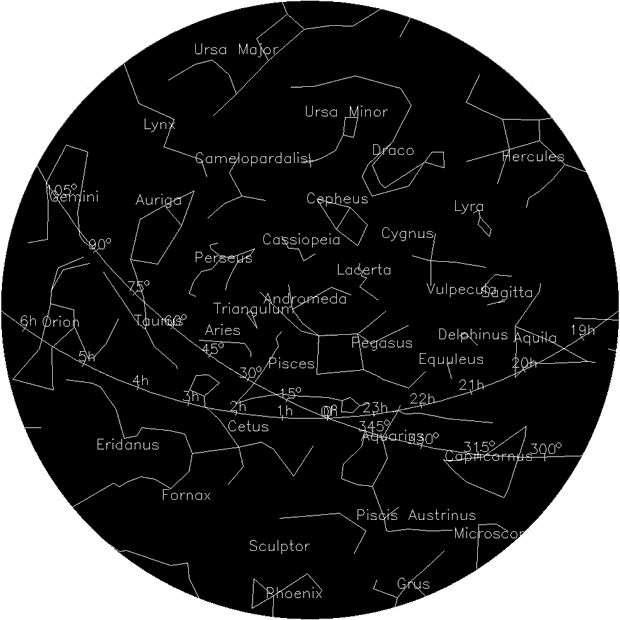NIGHT SKY HAPPENINGS
Moab
UT (at City Hall)
38O34’ N Latitude 109O33’ W Longitude
4048 ft - 1234 m |
The Sky for December 2017
By Faylene
Roth
Sunrise-Sunset
for December
(The time of sunrise and sunset assumes a flat horizon.
Actual time may
vary depending upon the landscape.) |
DATE |
SUNRISE |
SUNSET |
1 |
7:17am |
4:57pm |
2 |
7:18am |
4:57pm |
3 |
7:19am |
4:57pm |
4 |
7:20am |
4:57pm |
5 |
7:21am |
4:57pm |
6 |
7:22m |
4:57pm |
7 |
7:23am |
4:57pm |
8 |
7:24am |
4:57pm |
9 |
7:24am |
4:57pm |
10 |
7:25am |
4:57pm |
11 |
7:26am |
4:57pm |
12 |
7:27am |
4:57pm |
13 |
7:27am |
4:58pm |
14 |
7:28am |
4:58pm |
15 |
7:29am |
4:58pm |
16 |
7:30am |
4:59pm |
17 |
7:30am |
4:59pm |
18 |
7:31am |
4:59pm |
19 |
7:31am |
5:00pm |
20 |
7:32am |
5:00pm |
21* |
7:32am |
5:01pm |
22 |
7:33am |
5:01pm |
23 |
7:33am |
5:02pm |
24 |
7:34am |
5:02pm |
25 |
7:34am |
5:03pm |
26 |
7:35am |
5:04pm |
27 |
7:35am |
5:04pm |
28 |
7:35am |
5:05pm |
29 |
7:35am |
5:06pm |
30 |
7:36am |
5:06pm |
31 |
7:36am |
5:07pm |
*Winter Solstice 9:28am |
|
The eastern sky is brilliant with Magnitude 0, 1, and 2 stars: Aldebaran in Taurus, Rigel and Betelgeuse in Orion, Procyon in Canis Minor, Castor and Pollux in Gemini, and Sirius (brightest star in our night sky) in Canis Major. In addition to this cluster of red, blue, yellow, and white stars, take note of the Milky Way stretching across the northern sky from west to east with Magnitude 0, 1, and 2 stars in Aquila, Cygnus, Cassiopeia, Perseus, and Auriga. Cygnus takes a nosedive on the western horizon as it glides towards the galaxy’s center. In this position, it is often called the Northern Cross. To the east the Milky Way crosses the ecliptic in Gemini and continues between the two “dog” stars—Procyon and Sirius—thinning and trailing out to the edges of the galaxy where the dust, gases, and atoms of the Universe commingle. Our neighboring galaxy Andromeda can still be seen high overhead as a fuzzy blur between Cassiopeia and the northeast corner of the Great Square of Pegasus. Look for it along the western edge of the constellation Andromeda..
.Twilight extends the period of daylight in three stages at each end of the day. Morning twilight begins with astronomical twilight—about 1-1/2 hours (nearly 2 during summer months) before sunrise—as the eastern horizon brightens. Nautical twilight continues—as the overhead sky turns blue and color returns to the surrounding landscape—for another 30-40 minutes. The final stage—civil twilight—provides adequate light for most outdoor activities for the half hour before the sun crests the horizon. The opposite progression occurs after sunset.
VISIBLE PLANETS
Morning (At Twilight)
Mars – Look for a small red disk rising below Spica (Virgo) in the eastern sky around 3:30am. As the month progresses Mars trails farther below Spica and enters Libra on December 23. (Magnitude +1.6)
Jupiter – The brightest object in the December sky rises around 5:00am in Libra. At month’s end Jupiter rises just 15 minutes later than Mars. (Magnitude -1.7)
MOON HAPPENINGS
December 3 – Full moon (8:47am) rises at 5:32pm.
December 10 – Dark evening skies return with the waning last quarter moon rising after midnight.
December 18 – New moon (4:42am) yields dark skies for several nights.
December 26 – Waxing first quarter lights the evening sky then sets soon after midnight.
(The moon rises later each day—as little as 30 minutes to as much as one hour. Time of moonrise and moonset may also be delayed in mountainous terrain.)
Twilight is often the best time to look for Venus and Mercury because they frequently rise or set within one-half to one hour of sunrise or sunset. Twilight transitions between night and day in three stages at each end of the day. Morning twilight begins with astronomical twilight as the eastern horizon brightens —about 1-1/2 hours (nearly 2 during summer months) before sunrise when the sun is 18 ̊ below the horizon. Nautical twilight takes over for another 30-40 minutes—as the sun passes 12 ̊ below the horizon and the overhead sky turns blue and color returns to the surrounding landscape. The final stage—civil twilight—begins when the sun ascends to 6 ̊ below the horizon and provides adequate light for most outdoor activities for the half hour before the sun crests the horizon. The opposite progression occurs after sunset. Civil twilight covers the period after sunset during which daytime light quality persists for about one-half hour. Color then fades from the landscape during the 30-40 minute period of nautical twilight during which the overhead sky darkens while the western sky retains color. Astronomical twilight then transitions to night skies that are now darkened along the horizon.
MAJOR METEOR EVENTS |
Shower |
Peak
(Dec)
|
Range
(Dec) |
Constellation
Radiant |
Rate
(hr) |
Details |
Conditions
|
| Geminids |
13/14 |
1-17 |
Gemini |
60-120 |
Bright, colorful,
medium slow meteors –
10pm to dawn |
Waning quarter moon rises
after midnight |
Ursids |
21/22 |
17-22 |
Ursa Minor |
5-10 |
View 11pm to dawn
in early morning
December 22-24 |
New waxing moon sets
before midnight |
Best time to view any meteor event is between midnight and morning twilight when the radiant is overhead.
Trace the path of any meteor backwards through the sky to reach its radiant--the region of the sky from which meteors appear to originate. |
Primary Sources: USGS; U.S. Naval Observatory; Your Sky at http://www.fourmilab.ch/yoursky/
To find out when the space shuttle and International Space Station are visible from your location,
go to: http://spaceflight.nasa.gov/realdata/sightings/index.html and click on Sighting Opportunities.
The star chart approximates the sky from astronomical twilight to midnight. As the night and month progresses, the constellations shift toward the northwest. The celestial equator is measured in hours (h).
The ecliptic is measured in degrees
Note: Hold your hand at arm’s length to measure apparent distances in the sky. The width of the little finger approximates 1.5̊. Middle, ring, and little finger touching represent about 5̊. The width of a fist is about 10̊. The fist with the thumb extended at a right angle equals 15̊. The hand stretched from thumb to little finger approximates 20̊-25̊. The diameter of both the full moon and the sun spans only 0.5̊. Adjust for the size of your hand.
|


